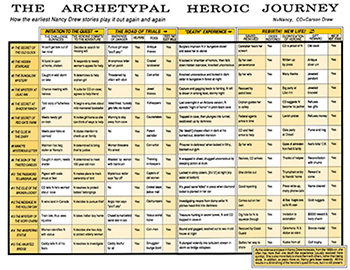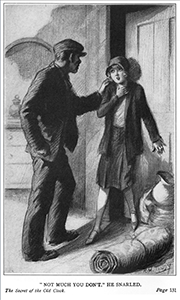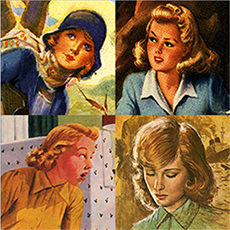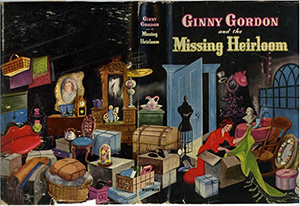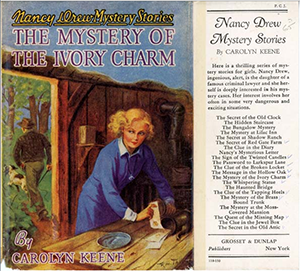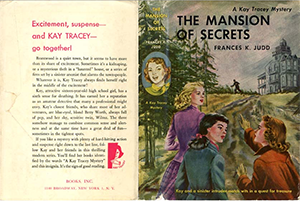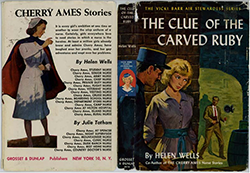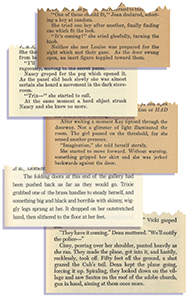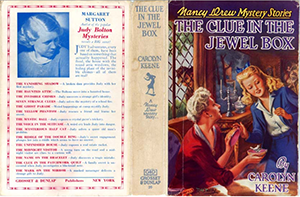Formula Fiction
The definition of girls’ series books by Nancy Drew scholar Sherrie A. Inness captures the essence of girl sleuth and career girl series books:
“Girls’ series typically star a girl, usually but not always a teenager, who, with or without friends, has exciting adventure after exciting adventure in a series of books that focus on her experiences.”
Sherrie Inness. Nancy Drew and Company, p. 3.
“Girl sleuth” books are often accused of being “formula fiction.” What are some of the formulas or conventions found in these books?
- Teenage heroine is motherless, fatherless, or orphaned
- Characters often do not age and there is little character development
- Common plots involve restoring missing inheritances and identities
- Setting is a vague location unable to be pinpointed on a map
- Clues often involve jewels, maps, diaries, wills, or letters
- Gothic and mysterious elements feature in the locations and plots
- Cliff-hanger chapter endings are common
- Typical villains are low-life characters, bullies, social climbers, or foreigners
- Stories refer to previous and following books in the series
- Lists of all the books in the series and other series books from the publisher are listed on the book covers
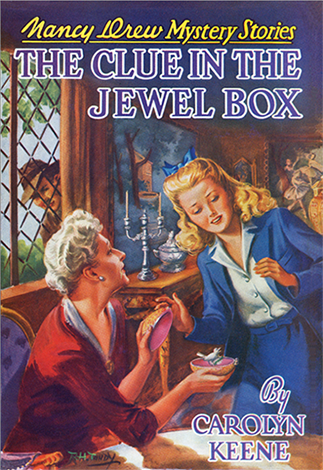
The Heroic Journey
Chart showing the formula of the mythic heroic quest as it appears in the Nancy Drew stories. Author Betsy Caprio argues that this shows that formula fiction is important psychologically.
Chart taken from The Mystery of Nancy Drew: Girl Sleuth on the Couch, Trabuco Canyon, Calif,: Source Books, 1992, pp 142-143.
The Villians
Girl sleuths often find themselves confronting stereotypical cold-hearted villains and crooks. Here, in her first adventure, Nancy is face to face with a “rough-looking” robber as he catches her spying from a closet.
Keene, Carolyn. The Secret of the Old Clock. New York: Grosset & Dunlap, 1930.
Ageless Heroines
One of the main elements that distinguishes a heroine in a girl series is her ability to stay forever young. Nancy Drew celebrated her 75th year in 2005; yet her face shows that over the years she has remained a fresh and young teenager who only aged from 16 to 18 when the legal driving age was raised.
The Secret of the Old Clock. New York: Grosset & Dunlap, 1930
The Mystery of the Tolling Bell. New York: Grosset & Dunlap, 1946
The Bungalow Mystery. New York: Grosset & Dunlap, 1950
The Strange Message in the Parchment. New York: Grosset & Dunlap, 1977.
The Plots
Many of the cases solved by the girl sleuths involve recovering lost or stolen inheritances. In this adventure, Ginny Gordon is on a hot case in search of a missing emerald pin.
Campbell, Julie. Ginny Gordon and the Missing Heirloom. Racine: Whitman Publishing, 1950.
What's the Next Book?
One of the signature marks of a girls’ series book is the reference to other books in the series, either within the text or on the dust jacket. It was not uncommon to find an explicit reference to the next book(s) in the series at the conclusion of an adventure. Here on the right, readers are given a preview of Connie Blair’s next great mystery.
Allen, Betsy. The Ghost Wore White. New York: Grosset & Dunlap, 1950.
Other Books in the Series
Every series book features a list of all the available books in the series. In this copy, a former owner has checked the books she has read (or already owns).
Keene, Carolyn. Mystery of the Ivory Charm, New York: Grosset & Dunlap, 1936.
Gothic Elements
Plot lines full of dark, mysterious and gothic elements often filled the pages of the girl sleuth books. This Kay Tracey adventure takes place in a spooky, deserted old mansion.
Judd, Frances K. The Mansion of Secrets. New York: Books, Inc., 1951.
The Clues
Finding “the clue” was an important motif in the girl detective mysteries. Often the clue involved common objects such as a twisted candle, an ivory charm or an old map. In this Vicki Barr mystery, a paper bag full of jewels serves as the clue that unlocks the mystery.
Wells, Helen. The Clue of the Carved Ruby. New York: Grosset & Dunlap, 1961.
Cliff-hanger Chapter endings
A favorite device to maintain suspense in series books is the use of cliff-hanger situations at the end of chapters. Below are some chapter endings using this technique:
Dana Girls
Keene, Carolyn. The Clue of the Rusty Key , p. 29. New York: Grosset & Dunlap, 1942.
Nancy Drew
Keene, Carolyn. The Quest of the Missing Map, p. 127. New York: Grosset & Dunlap, 1942.
Kay Tracey
Judd, Frances K. In the Sunken Garden, p. 79. New York: Cupples & Leon Company, 1939.
Trixie Belden
Campbell, Julie. The Mysterious Visitor, p. 105. New York: Random House, 1954.
Vicki Barr
Wells, Helen. The Hidden Valley Mystery, p. 203. New York: Grosset & Dunlap, 1948.
Conventions in action
The Clue in the Jewel Box incorporates many of the conventions of the girl sleuth genre: the plot includes a search for a former queen’s grandson and a secret formula in a “Faber” jewel box. Notice the villain peeking in the window.
Keene, Carolyn. The Clue in the Jewel Box. New York: Grosset & Dunlap, 1943.


